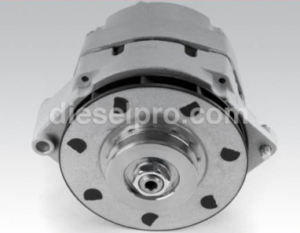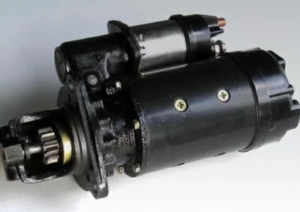
The alternators and starters in Detroit Diesel 53 Series engines are essential components that provide reliable power supply and engine starting. Proper maintenance of these components ensures efficient performance, reduces downtime, and prevents costly repairs. This comprehensive guide explores the construction, functionality, maintenance procedures, common issues, and troubleshooting techniques for alternators and starters.
Starters & Alternators & Related Components for Detroit Diesel 353 Non–Turbo Marine & Industrial Engines
Starters & Alternators & Related Components for Detroit Diesel 353 Turbo Marine & Industrial Engines
Starters & Alternators & Related Components for Detroit Diesel 453 Non – Turbo Marine & Industrial Engines
Starters & Alternators & Related Components for Detroit Diesel 453 Turbo Marine & Industrial Engines
Starters & Alternators & Related Components for Detroit Diesel 6V53 Non – Turbo Marine & Industrial Engines
Starters & Alternators & Related Components for Detroit Diesel 6V53 Turbo Marine & Industrial Engines
Starters & Alternators & Related Components for Detroit Diesel 8V53 Non – Turbo Marine & Industrial Engines
Starters & Alternators & Related Components for Detroit Diesel 8V53 Turbo Marine & Industrial Engines
Understanding Alternators in Detroit Diesel 53 Series Engines
Role of the Alternator

The alternator converts mechanical energy from the engine into electrical energy to power the vehicle’s electrical systems and charge the battery. Without a properly functioning alternator, the engine and other systems would rely solely on the battery, leading to rapid depletion and failure.
Key Components of an Alternator
- Rotor and Stator:
- The rotor creates a magnetic field as it spins within the stator.
- The stator contains windings where this magnetic field induces an electrical current.
- Rectifier Assembly:
- Converts the alternator’s alternating current (AC) into direct current (DC) for use by the battery and electrical systems.
- Converts the alternator’s alternating current (AC) into direct current (DC) for use by the battery and electrical systems.
- Voltage Regulator:
- Controls the output voltage of the alternator, maintaining it within the range of 13.8 to 14.2 volts to prevent overcharging or undercharging the battery.
- Controls the output voltage of the alternator, maintaining it within the range of 13.8 to 14.2 volts to prevent overcharging or undercharging the battery.
- Drive Belt and Pulley:
- The alternator is driven by the engine via a belt connected to a pulley. The condition and tension of this belt are critical to the alternator’s operation.
- The alternator is driven by the engine via a belt connected to a pulley. The condition and tension of this belt are critical to the alternator’s operation.
Alternator Maintenance Procedures
1. Visual Inspection
- Inspect the alternator housing for cracks, corrosion, or physical damage.
- Ensure that electrical connections are secure and free from corrosion.
2. Drive Belt Maintenance
- Check the condition of the belt driving the alternator for signs of wear, such as fraying, cracks, or glazing.
- Verify proper belt tension. A loose belt can slip and reduce alternator output, while an overly tight belt can strain the pulley and bearings.
3. Output Voltage Testing
- Use a multimeter to test the alternator’s output voltage at the battery terminals:
- At idle, the voltage should range between 13.8 and 14.2 volts.
- A reading below 13.5 volts indicates undercharging, while a reading above 14.5 volts suggests overcharging.
4. Cleaning
- Keep the alternator free from grease, oil, and debris to prevent overheating and maintain efficiency.
5. Bearing Inspection and Replacement
- Alternator bearings can wear out over time, leading to noise and reduced efficiency. Replace bearings if excessive play or grinding noise is observed.
Common Alternator Issues and Troubleshooting
1. Low Voltage Output
- Causes: Worn brushes, faulty diodes in the rectifier assembly, or a damaged voltage regulator.
- Solutions: Inspect and replace worn or damaged components.
2. No Voltage Output
- Causes: Broken rotor windings, open circuits in the stator, or complete failure of the rectifier assembly.
- Solutions: Test each component and replace as necessary.
3. Overcharging
- Causes: Faulty voltage regulator or a short circuit in the wiring.
- Solutions: Replace the voltage regulator and inspect the wiring harness for damage.
4. Noisy Operation
- Causes: Worn bearings or misaligned drive belts.
- Solutions: Replace bearings and adjust the drive belt alignment and tension.
Understanding Starters in Detroit Diesel 53 Series Engines
Role of the Starter Motor

The starter motor initiates engine operation by cranking the engine’s crankshaft. It relies on a powerful burst of electrical energy from the battery to generate sufficient torque for starting.
Key Components of a Starter Motor
- Armature and Field Windings:
- The armature rotates within the magnetic field created by the windings, converting electrical energy into mechanical torque.
- The armature rotates within the magnetic field created by the windings, converting electrical energy into mechanical torque.
- Solenoid:
- The solenoid acts as a switch to engage the starter motor when the ignition key is turned.
- The solenoid acts as a switch to engage the starter motor when the ignition key is turned.
- Bendix Drive (Starter Drive):
- The Bendix drive engages with the engine’s flywheel to transmit torque for cranking.
- The Bendix drive engages with the engine’s flywheel to transmit torque for cranking.
- Brushes and Commutator:
- These components ensure electrical contact and current flow to the armature.
- These components ensure electrical contact and current flow to the armature.
- Housing and Bearings:
- The housing protects internal components, and the bearings support the armature for smooth rotation.
- The housing protects internal components, and the bearings support the armature for smooth rotation.
Starter Motor Maintenance Procedures
1. Visual Inspection
- Inspect the starter housing for cracks, corrosion, or signs of overheating.
- Check the electrical connections for looseness or corrosion.
2. Load Testing
- Use a starter load tester to evaluate the motor’s performance under load. Excessive current draw can indicate internal faults.
3. Cleaning and Lubrication
- Clean the starter motor’s exterior and the Bendix drive to remove dirt and debris.
- Apply a light lubricant to the Bendix drive gear to ensure smooth engagement with the flywheel.
4. Brush and Commutator Maintenance
- Inspect the brushes for wear and replace if they are worn beyond their specified length.
- Clean the commutator with fine sandpaper to remove carbon buildup.
5. Solenoid Testing
- Test the solenoid for continuity and proper operation. Replace if it fails to engage the starter motor reliably.
Common Starter Issues and Troubleshooting
1. Starter Fails to Engage
- Causes: Weak battery, faulty solenoid, or worn Bendix drive.
- Solutions: Check the battery’s charge, replace the solenoid, or inspect and replace the Bendix drive.
2. Slow Cranking Speed
- Causes: Low battery voltage, excessive internal resistance, or worn brushes.
- Solutions: Charge the battery, clean electrical connections, and replace worn brushes.
3. Grinding Noise During Start
- Causes: Damaged Bendix drive gear or worn flywheel teeth.
- Solutions: Inspect and replace damaged components.
4. Intermittent Operation
- Causes: Loose electrical connections or a failing solenoid.
- Solutions: Tighten connections and replace the solenoid if necessary.
Preventive Maintenance Tips for Alternators and Starters
- Regular Inspections:
- Conduct routine visual inspections to identify potential issues before they escalate.
- Conduct routine visual inspections to identify potential issues before they escalate.
- Clean Connections:
- Keep all electrical connections clean and tight to ensure reliable operation.
- Keep all electrical connections clean and tight to ensure reliable operation.
- Protect Against Moisture:
- Ensure that alternators and starters are protected from excessive moisture to prevent corrosion.
- Ensure that alternators and starters are protected from excessive moisture to prevent corrosion.
- Replace Worn Components Promptly:
- Address worn bearings, brushes, or other parts immediately to avoid more extensive damage.
- Address worn bearings, brushes, or other parts immediately to avoid more extensive damage.
- Monitor Electrical System Health:
- Regularly test battery voltage and alternator output to detect issues early.
- Regularly test battery voltage and alternator output to detect issues early.
By adhering to these maintenance practices and troubleshooting techniques, you can ensure reliable performance from the alternators and starters in your Detroit Diesel 53 Series engine. Proper care of these critical components will reduce downtime, extend their lifespan, and enhance overall engine reliability.
Starters & Alternators & Related Components for Detroit Diesel 353 Non–Turbo Marine & Industrial Engines
Starters & Alternators & Related Components for Detroit Diesel 353 Turbo Marine & Industrial Engines
Starters & Alternators & Related Components for Detroit Diesel 453 Non – Turbo Marine & Industrial Engines
Starters & Alternators & Related Components for Detroit Diesel 453 Turbo Marine & Industrial Engines
Starters & Alternators & Related Components for Detroit Diesel 6V53 Non – Turbo Marine & Industrial Engines
Starters & Alternators & Related Components for Detroit Diesel 6V53 Turbo Marine & Industrial Engines
Starters & Alternators & Related Components for Detroit Diesel 8V53 Non – Turbo Marine & Industrial Engines
Starters & Alternators & Related Components for Detroit Diesel 8V53 Turbo Marine & Industrial Engines



 Free US Calls: 1-888-433-4735
Free US Calls: 1-888-433-4735 International: 305-545-5588
International: 305-545-5588